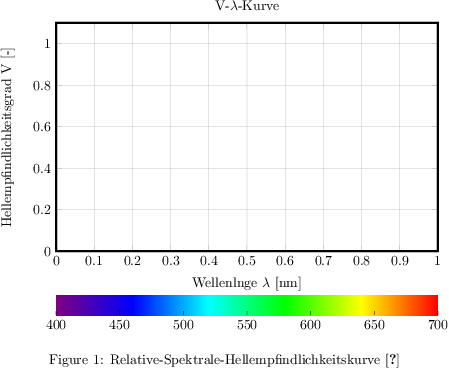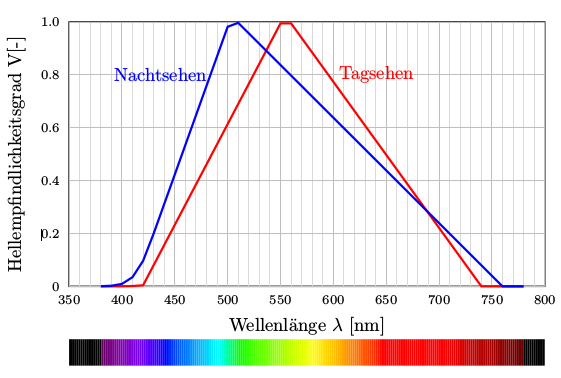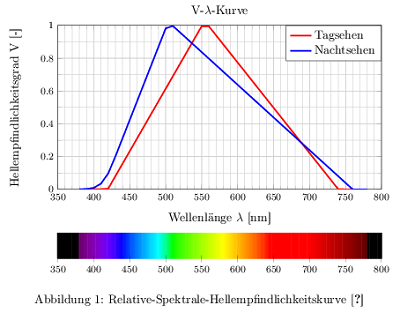|
Hallo, ich würde gerne eine Ich habe das nun soweit umgeändert, wie es Henry mir gesagt hat, jedoch passt die Welle nicht mit der x-Achse überein. Ich habe zusätzlich ein paar Werte der .csv Datei hinzugefügt. Hoffe ihr koennt mir weiterhin helfen! \documentclass[10pt,a4paper]{article} \usepackage[latin1]{inputenc} \usepackage{amsmath} \usepackage{amsfonts} \usepackage{amssymb} \usepackage{xcolor} \usepackage{pgfplots} \usetikzlibrary{ quotes, angles, babel, calc, 3d, intersections, shapes, } \usepackage{tikz} \usepackage{graphicx} \begin{document} \begin{figure}[h] \centering \begin{tikzpicture} \begin{axis}[ymin=0,grid, width=0.9\textwidth, height=0.3\textheight, %xmin = 350, %xmax = 750, %geringer wie 750 kann ich hier leider nicht gehen title = {V-$\lambda$-Kurve}, axis line style={ultra thick}, xlabel={Wellenlänge $\lambda$ [nm]}, ylabel={Hellempfindlichkeitsgrad V [-]}, legend style={at={(1,1)}, anchor=north east, nodes=right}, name=main ] \addplot [no marks, very thick, red]table {Tagsehen.csv}; \addplot [no marks, very thick, blue]table {Nachtsehen.csv}; \legend{Tagsehen, Nachtsehen}; \end{axis} \begin{scope}[shift=(main.below south west)] \shade[shading=rainbow,shading angle=90] (0,0) rectangle +(0.8\textwidth,-.5); \foreach \lambda in {400,450,...,700} { \draw ({(\lambda-400)/300*0.8\textwidth},-.4) -- ({(\lambda-400)/300*0.8 \textwidth},-.5) node [below] {\lambda}; } \end{scope} \end{tikzpicture} \caption {Relative-Spektrale-Hellempfindlichkeitskurve \cite{Reif.2014}} \label{Vlambda} \end{figure} \end{document} Ein paar Werte für das Tag- und Nachtsehen sind Tagsehen 380 0 390 0.0001 400 0.0004 410 0.0012 420 0.004 550 0.995 560 0.995 740 0.00025 750 0.00012 760 0.00006 770 0.00003 780 0.000015 Nachtsehen 380 0.000589 390 0.002209 400 0.00929 410 0.03484 420 0.0966 430 0.1998 500 0.982 510 0.997 760 0.000000425 770 0.000000241 780 0.000000139 |
|
Ich würde kein \documentclass{article} \usepackage{pgfplots} \pgfdeclareverticalshading{rainbow}{100bp} {color(0bp)=(red); color(25bp)=(red); color(35bp)=(yellow); color(45bp)=(green); color(55bp)=(cyan); color(65bp)=(blue); color(75bp)=(violet); color(100bp)=(violet)} \begin{document} \begin{figure}[h] \centering \begin{tikzpicture} \begin{axis}[ymin=0,grid, scale only axis, width=0.8\textwidth, height=0.3\textheight, xmin = 550, xmax = 800, title = {V-$\lambda$-Kurve}, axis line style={ultra thick}, xlabel={Wellenlänge $\lambda$ [nm]}, ylabel={Hellempfindlichkeitsgrad V [-]}, legend style={at={(1,1)}, anchor=north east, nodes=right}, name = main, ] \draw [->] (0,0) -- (5,0) node [midway, below] {Text}; % \addplot [no marks, very thick, red]table {Tagsehen.csv}; % \addplot [no marks, very thick, blue]table {Nachtsehen.csv}; \legend{Tagsehen, Nachtsehen}; \end{axis} \begin{scope}[shift=(main.below south west)] \shade[shading=rainbow,shading angle=90] (0,0) rectangle +(0.8\textwidth,-.5); \foreach \lambda in {400,450,...,700} { \draw ({(\lambda-400)/300*0.8\textwidth},-.4) -- ({(\lambda-400)/300*0.8\textwidth},-.5) node [below] {\lambda}; } \end{scope} \end{tikzpicture} \caption {Relative-Spektrale-Hellempfindlichkeitskurve \cite{Reif.2014}} \label{Vlambda} \end{figure} \end{document}
Hallo Henri, Super, vielen Dank dir! Ich kann hier leider nicht komplett antworten, deswegen schreibe ich dies alles in eine neue Frage, unter meinen jetzigen Post!
(23 Aug '16, 10:24)
Starboma
@Starboma Verfasse für jede neue Frage eine neue Frage :-) Hier sind Antworten stets "echte" Antworten, keine Gespräche oder Rückfragen oder Zusatzinfos, sondern Lösungen. Ungewohnt und anders als in Web-Diskussions-Foren, doch innovativ und nutzbarer als sortierte Archivlösung. Keine Sorge, Henri und wir anderen sehen die neue Frage auch.
(23 Aug '16, 16:23)
stefan ♦♦
|
|
Das folgende mit \documentclass{article} \usepackage{filecontents} \begin{filecontents*}{tag.dat} 380 0 390 0.0001 400 0.0004 410 0.0012 420 0.004 550 0.995 560 0.995 740 0.00025 750 0.00012 760 0.00006 770 0.00003 780 0.000015 \end{filecontents*} \begin{filecontents*}{nacht.dat} 380 0.000589 390 0.002209 400 0.00929 410 0.03484 420 0.0966 430 0.1998 500 0.982 510 0.997 760 0.000000425 770 0.000000241 780 0.000000139 \end{filecontents*} \usepackage{fontspec} \usepackage{pst-spectra,pst-plot} \begin{document} \begin{pspicture}(-1,-1.5)(9.1,5.1) \psaxes[Ox=350,Dx=50,dx=1,xticksize=0 5,yticksize=0 9, xsubticks=5,xsubticksize=1,xsubtickcolor=black!15, tickcolor=black!25,Dy=0.2,dy=1,labelFontSize=\scriptstyle, axesstyle=frame](0,0)(9,5) \readdata{\tag}{tag.dat}\readdata{\nacht}{nacht.dat} \pstScalePoints(1,1){350 sub 50 div}{5 mul} \pslistplot[linecolor=red,linewidth=1.2pt,plotstyle=line]{\tag} \pslistplot[linecolor=blue,linewidth=1.2pt,plotstyle=line]{\nacht} \rput[l](5.1,4){\textcolor{red}{Tagsehen}} \rput[r](2.6,4){\textcolor{blue}{Nachtsehen}} \psspectrum[begin=350,end=800](0,-1)(9,-1.5) \rput{90}(-1,2.5){Hellempfindlichkeitsgrad V[-]} \rput(4.5,-0.75){Wellenlänge $\lambda$ [nm]} \end{pspicture} \end{document}
|
|
Ich würde es so machen:
In der axis-Umgebung Koordinaten festlegen: % Lichtsprektrum 1von2 "Koordinaten festlegen" \foreach \W in {350,...,800} { \edef\temp{\noexpand\coordinate (Koord\W) at (axis cs:\W,0);} \temp } In der tikzpicture-Umgebung zeichen, so dass Lichtsprektrum genau unter der x-Koordinatenachse erscheint: % Lichtsprektrum 2von2 "zeichnen" \foreach \LAMBDA in {350,...,800} { \storeRGBofWavelength{\Rval}{\Gval}{\Bval}{\LAMBDA} \definecolor{Name}{rgb}{\Rval,\Gval,\Bval} \draw[Name, thick] ([yshift=-2cm]Koord\LAMBDA)--([yshift=-1.25cm]Koord\LAMBDA); } %
\RequirePackage{filecontents} \begin{filecontents}{Tagsehen.csv} 380 0 390 0.0001 400 0.0004 410 0.0012 420 0.004 550 0.995 560 0.995 740 0.00025 750 0.00012 760 0.00006 770 0.00003 780 0.000015 \end{filecontents} % \begin{filecontents}{Nachtsehen.csv} 380 0.000589 390 0.002209 400 0.00929 410 0.03484 420 0.0966 430 0.1998 500 0.982 510 0.997 760 0.000000425 770 0.000000241 780 0.000000139 \end{filecontents} %\documentclass[border=5pt, varwidth]{standalone} \documentclass[10pt,a4paper]{article} \usepackage{selinput} \SelectInputMappings{adieresis={ä}, germandbls={ß}} \usepackage[ngerman]{babel} \usepackage[T1]{fontenc} \usepackage{microtype} \usepackage{amsmath, amsfonts, amssymb} \usepackage{xcolor} \usepackage{pgfplots} \usetikzlibrary{quotes,angles,babel,calc,3d,intersections,shapes,} \usepackage{tikz} \usepackage{graphicx} \usepackage{colorwav} \begin{document} \begin{figure}[h] \centering \begin{tikzpicture} \begin{axis}[ % Allgm. width=0.9\textwidth, height=0.3\textheight, title = {V-$\lambda$-Kurve}, xlabel={Wellenlänge $\lambda$ [nm]}, ylabel={Hellempfindlichkeitsgrad V [-]}, legend style={at={(1,1)}, anchor=north east, nodes=right}, %name=main, % x: xmin = 350, xmax = 800, minor xtick={350,360,...,800}, % y: ymin=0, ymax=1, ytick distance=0.2, minor ytick={0.1,0.2,...,1}, % x und y: grid =both, %both, %major, minor ticklabel style = {font=\footnotesize} %axis line style={thick}, ] \addplot [no marks, very thick, red]table {Tagsehen.csv}; \addplot [no marks, very thick, blue]table {Nachtsehen.csv}; \legend{Tagsehen, Nachtsehen}; % % Lichtsprektrum 1von2 "Koordinaten festlegen" \foreach \W in {350,...,800}{ \edef\temp{\noexpand\coordinate (Koord\W) at (axis cs:\W,0);} \temp } \end{axis} % % Lichtsprektrum 2von2 "zeichnen" \foreach \LAMBDA in {350,...,800}{ \storeRGBofWavelength{\Rval}{\Gval}{\Bval}{\LAMBDA} \definecolor{Name}{rgb}{\Rval,\Gval,\Bval} \draw[Name, thick] ([yshift=-1.25cm]Koord\LAMBDA)--([yshift=-2cm]Koord\LAMBDA); } % Zusatz "Skala für Lichtspektrum" \foreach \Lambda in {350,400,...,800}{ \draw[very thin] ([yshift=-1.9cm]Koord\Lambda)--([yshift=-2.1cm]Koord\Lambda) node[below, font=\footnotesize]{\Lambda}; } % \end{tikzpicture} \caption {Relative-Spektrale-Hellempfindlichkeitskurve \cite{Reif.2014}} \label{Vlambda} \end{figure} \end{document} |




Siehr auch hier: http://texwelt.de/wissen/fragen/12608/lichtspektrum-in-tikz-zeichnen mit colorwav.sty